

10th May 2022
Article
The intersection between art, empowerment and peacebuilding
Aya Abu Hawash
The intersection between art, empowerment and peacebuilding
Interview with Aya Abu Hawash, member of OGIP’s Youth Advocates Network, Visual Artist, Art Curator and Art Trainer in Community Mobilisation

Photo of Curators Aya Abu Hawash & Ranine El Homsi
Aya Abu Hawash is a female visual artist, Art educator and an advocate of the Women Peace and Security and the Youth Peace and Security agendas in the Middle East. She creates and curates art as a form of education and aims to promote peace and collaboration through her work by opening up dialogue and healing with those who don’t traditionally engage in the policy world. Through her work, Aya also aims to highlight the powerful messages of women artists, particularly those from Lebanon and the Middle East where she is based. Over the past 4 months she has been working on a project with Curator Ranine El Homsi, she's an interior designer, art critic and curator with more than 10 years of experience in the art & cultural field.
Hunna هنً* is an exhibition that celebrates women artists, through artwork it explores the role of women in Lebanon across multiple spheres of society. Hunna هنً* is a sensorial voyage, an invitation to enter the world of women. The exhibition offers a wide array of encounters through paintings, drawings, sculptures, photography, videos and a parallel program.
Hunna is an art exhibition of more than 50 artists with a vast majority of women participating in the show. Despite the difficult Lebanese context, Aya and Ranine insisted on having the opening of the exhibition on women's day as for them, it was a crucial occasion to celebrate Lebanese women and women artists. Alongside the exhibition there is a parallel cultural program including talks, screening and workshops which engages a vast array of visitors with the topics the exhibition is exploring. Through these activities everyone can feel involved and get in touch with art and the subjects represented by the artists on different levels.
Participants:
Sara Abou Mrad, Flavia Codsi, Serene Ghandour,Aya Abu Hawash, Rémie Akl, Fatima Mortada, Dzovig Arnelian,Emma Fern Curtis, Manuella Guiragossian, Diana Assaker, Effa Mseileb, Lara Zankoul, Chloe Sfeir, Manar Ali Hassan,Jessica Hajj Choueiri, Roula Azrak, Nicole Mezher, Joëlle Tomb,Perrine Hebraud, Arpy Gokceyan, Nicole Berjon Bouldoukian,Shayma Kamel, Rawia Zantout, Joëlle Olga Feghali,Tatiana Boulos, Maysam Hindy, Guitta Melki, Sara Schaub,Joanna Raad, Ghina Nahle-Bauer, May Haddad, Wadad Yazbeck, Louma Rabah, Maral Maniss, Gulene Torossian DerBoghossian, Waed Quayder, Tharwa Zeitoun, May Abboud, Zyara, Documentary series, Rime Kesserwan, Celine Seta Rahme,Michelle Khalil, Rita Adaimy and Chantal Zailaa.Mansour El Habre, Kameel Hawa, Ryan Eid, Anthony AbouJaoudé, Eddy Choueiry, Philippe Aractingi, Fulvio Codsi, Nicolas Tawk, Wissam Eid, Hussein Baydoun, Rolf Dergham,Tom Young, Jean-Marc Nahas, Ammar Abd Rabbo, Simon Mhanna and Hady Baydoun.
The exhibition is running from 8 March to 28 May, 2022. You can find the exhibition at ABC Art Space , Level 3, Verdun, Beirut, Lebanon.
Download the exhibition's catalogue here to know more about the participating artists.
For the "Hunna هنً " collective exhibition virtual viewing check ABC Art Space Online.
Interview with artist Aya Abu Hawash
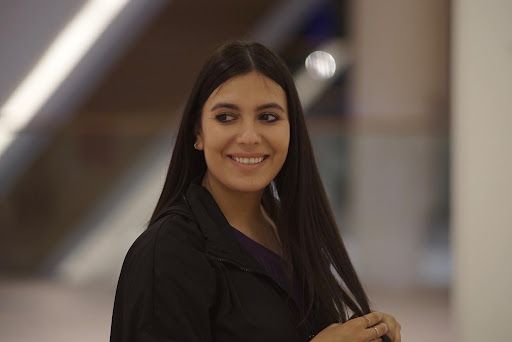
Aya Abu Hawash | Photo Credits Rolf Dergham
Why was it important for you to create Hunna هنً* ?
As a woman artist, I question my environment. There have always been a kind of euphoria of grief, a degree of madness in Art that often leads me to rethink a question “Do we need Art to fight our battles?
Hunna هنً* came as a way for each woman artist who needs to tell their stories and to communicate something to the world. It's a way for them to fight their battles. Curating Hunna Exhibition was very important to show the human side of the different women artists from the Middle East by defining themselves and highlighting their everyday challenges. Added to this, creating Hunna هنً* was an artist's strength that make women able to exist with their passion, creativity, perspective & depth.
Why do you use art as a form of education and communication?
As a former Art educator who worked with different Schools and NGOs I think art is an essential form of education and a tool that should be accessible for each student. Art tackles political, social and environmental issues. Promoting social awareness through art is a powerful tool that is neglected globally. As a youth advocate, I really care about promoting social awareness through art, because young people should be encouraged to participate in conflict resolution through art. Art nurtures a voice for oppressed groups and refugees, and me as a refugee I always find art as a form of intellectual property, it takes a deeper understanding and depth before one can interpret art.
Also art is a powerful form of communication. Throughout the exhibition I wanted people to figure out that art is a peaceful tool for women and youth to communicate because it can express political ideas, reinforce religion, or convey deeply personal thoughts. We need this kind of communication here in the Middle East and around the world because women and men of all genders have been communicating in a way that promotes violence, inequity and inequality. Reflecting women's challenges and concerns was a necessary dialogue that the Hunna هنً* exhibition explores.
Can you tell us about your experience using art as a method of peacebuilding? Why do you think art is important in this setting?
Arts targets children and youth. Art can act as a positive distraction for children suffering either directly or indirectly from conflicts in Arab communities. It’s a form of self-expression that simultaneously provides them with an outlet for their emotions, opinions, and hopes for the future. During my art training sessions with youth and refugees in Lebanon, I encountred different challenges. I used art as a method for peacebuilding through two projects. In my first project with Generation for peace, I trained students to create comic art to express their personal storie s and conflicts. Each participant reflected on what kind of challenges they are facing as refugees, and youth living under war and conflicts in the middle east. In my second project with Rotary 2452, we used art comics to create an educational game to fight bullying at schools and we won First prize for the "Civil Education for Peace Project '' in the Rotary Region 2452, with Rotary Saida.
As a past art trainer what does the art you create and curate reveal about the Women, Peace and Security and Youth, Peace and Security agendas?
The WPS and YPS agendas intersect with the art agenda worldwide. Art is a tool for peacebuilding and advocacy. Hunna هنً* exhibition introduces topics like ecofeminism, gender equality, and women’s empowerment. Women have been preoccupied through history, they were giving life to generations and raising them, this effort and responsibility is placed on womens shoulders, it enables them to turn pain into love and scars into strength.
Artists and curators have a responsibility to create new narrative and a platform of solidarity with women and youth around the world.Creating and curating art is a process of documenting reality and raising awareness. Art reveal’s that women must be critical actors in all efforts to achieve sustainable international peace and security as the Women, Peace and Security (WPS) framework that recognizes. Art promotes women's equal and meaningful participation in peace processes, peacebuilding and security through developing empathy through art and imparts leadership skills so women and children can co-create a peaceful future for their community. Achieving the WPS and YPS agendas through art has an impact on United Nations (UN)-brokered peace processes. Art is a resource that is available for use in all stages of a conflict. Through art, young people are encouraged to create their own visions and plans for the end of war.
Spotlight on 7 artist from Hunna هنً*
The exhibition Hunna هنً* contains almost 200 art pieces from 44 women and 16 men aged 25 to 75 years. Below we highlight 7 artists whose work explores the themes of gender, peace and security - from our relationship with the environment to women’s role in revolution to increasing gender based violence.
Aya Abu Hawash
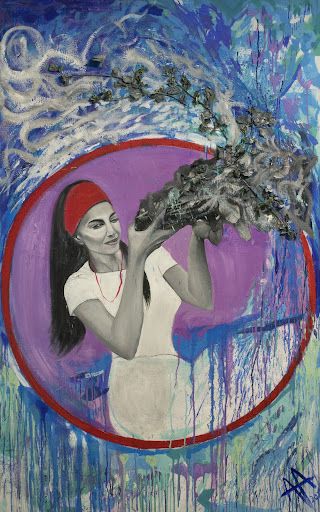
Paol’s Gun |Paola El Sitt | Oil on canvas 190x120cm |
Aya is a visual artist who grew up in Lebanon. Her practice is influenced by her identity as a Palestinian Lebanese woman and the many ways that society pressures her to conform. Her recent body of work addresses intimate themes of self-exploration and reinterpreting politics and social surroundings within a censored historical and political memory in the Middle East. Riffing on politics, history & media trends.
Aya worked as an Art trainer and educator. She also forms a part of the Rotaract club in Lebanon and was selected to be a member of the OGIP Advocacy network. In 2019, she coordinated "Civil Education for Peace building Project" with Rotary Saida and Institut Français in Lebanon, the project won First prize for Rotary district 2452. In 2020, she was awarded 4th place for a work created for ESCWA and Arab Institute for Youth Art Competition during 16 Days of Activism against Gender-Based Violence
“The moments I create are intimate spaces and dialogues between perceived society standards, and stereotypes which function to both challenge Arab women”
Rémie Ak
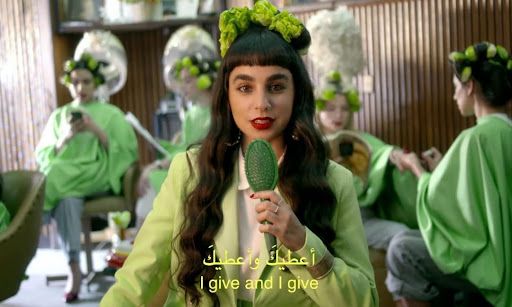
Rémie is a multidisciplinary artist from Beirut. The singer, visual artist, poet, and actress is passionate about her oriental Arab heritage, combining singing and dancing as an outlet for her ideas and inspiration. Immersed in youth, modernity, and street culture, Rémie’s work showcases the beauty inherent in her Arabic language and identity and offers a new perspective on the traditional pop scene in the Levant. Among her most notable productions is “Baklava Got Legs”, a spoken-word piece that saw her team up with gender equality NGO, ABAAD, to produce a poignant video addressing sexual harassment.
Emma Fern Curtis
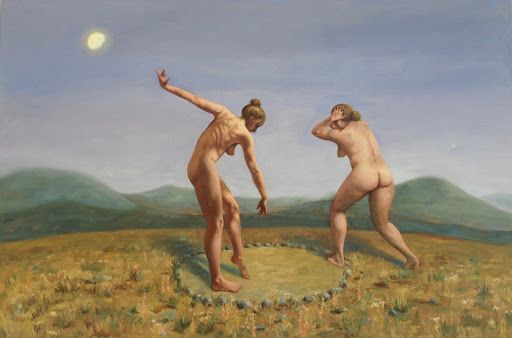
At the Border's Edge | 80x120cm | oil on canvas | 2021
Emma American painter lives in Falougha, Lebanon, where she works out of her home studio. Her aim is not to present a concrete story or interpretation of each painting. Her wish is rather to allow the opportunity for each viewer, with their own experiences, to find for themselves an individual meaning and relevance within the work.
“A kind of longing began to show through-perhaps a longing for connection and harmony with the Earth; connection with others, as represented by the circles the figures are placed in; a connection with the Self.”
Sara Abou Mrad

Sous les platanes de la Côte d’Azur Collection Matilda| 88x205cm | 2021
Sara is an eclectic painter born in Beirut in 1988.Fine Arts graduate from the Lebanese University. In September 2020, she was accepted for an art residency at the "Cité Internationale des Arts" in Paris as a beneficiary of a scholarship from the French Institute in Lebanon. She taught arts for 10 years and also created an art-based program designed to train blind children and help their integration into society.
She has participated in several exhibitions in Lebanon and abroad.She was the First-prize winner of the German Goethe Institute in 2011 and 2013 for the translation of classical music into painting. She won the competition "Call of Young Artists of Lebanon '' organized by the Museum of the Arab World Institute in Paris and the fund of "Claude and France Lemand '' in 2020.
Hussein Baydoun
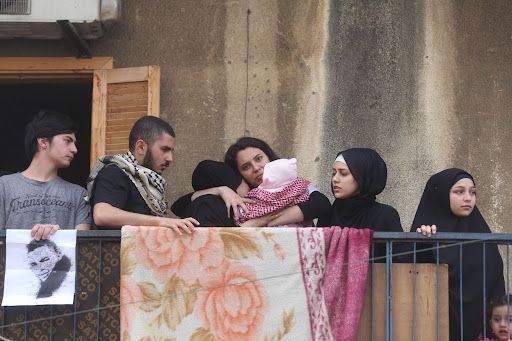
Untitled | Photo print on dibond alu | 42 x 59.4 cm
Hussein has been working as a photojournalist for 13 years for several local news websites and international agencies. He has participated in exhibitions with ICRC, UNDP, and Visa Pour l’Image as well as other projects. He is currently working as a photojournalist at Al Araby Al Jadeed newspaper and website.
Philippe Aractingi
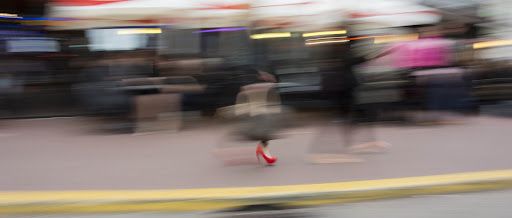
Talon volé 53 |100x75 cm| Glossy paper on +diasec | 2000
A poet at heart, he lived, and still does, to make others dream. Born in Beirut in 1964, Philippe Aractingi is a French-Lebanese filmmaker photographer.Self-taught, he discovered his passion at the early age of 8, when his father gifted him his first instant camera.
He directed and produced films and over documentaries and 4 award-winning long feature
Artist statement for the short film Thawra SOUL screening at Hunna exhibition.
“Everything I had written, everything I had tried to say in my films, all the notions of freedom, ecumenism, non-confessionalism, and revolt, was there, being proclaimed by the crowd in front of me. All that remains is the energy of this revolution, which is still unfinished. A magnificent energy that lifted us up for a few months. This film is a tribute to that energy.”
Tom Young

Mary Borden (Lady Spears) |60 x 55cm oil on canvas | 2022
Tom Young, a British artist paints the changing nature of Beirut, the city which has been his home since 2009. Influenced by his architectural training, he depicts the city's multi-layered architecture and public spaces, exploring how they embody emotion and political change.
He explores themes of memory, transformation, and coexistence. Whilst expressing the vulnerability of urban heritage in the face of modern development and sudden trauma, he creates a transcendent feeling of light and space.
Tom Young combines his painting practice with historical research, architectural conservation, and art therapy for children- transforming disused heritage buildings into living centers of culture and education.
You can view the full exhibition and support women artists in Lebanon, through buying thier artworks on ABC Art Space Online. For "Hunna هنً " collective exhibition privileged virtual viewing Follow Curatrices Projects and #Hunnaexhibition

